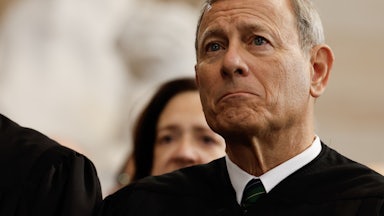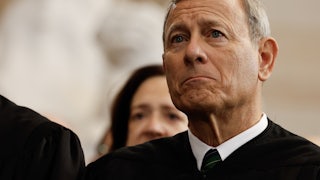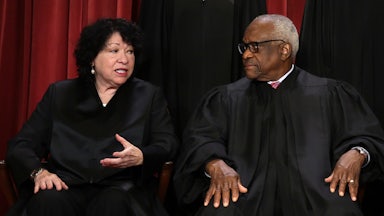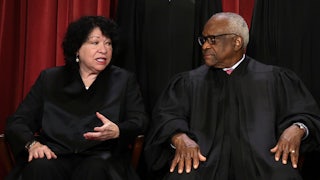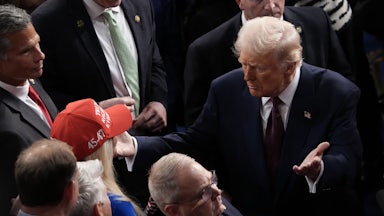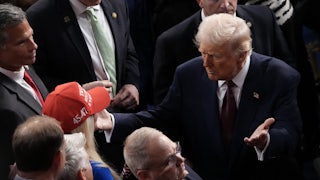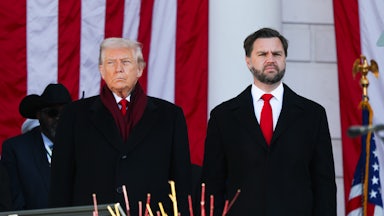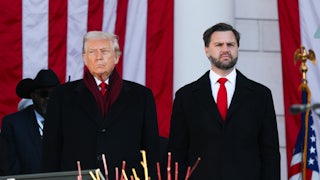The Supreme Court warned President Donald Trump on May 22 that he could not lawfully fire members of the Federal Reserve’s board of governors. It took him only 95 days to ignore them.
Trump sent a letter to Federal Reserve Governor Lisa Cook on Monday to inform her that “there is sufficient cause to remove you from your position,” and claimed that he had done so, “effective immediately.” It is the first time that a president has tried to fire a member of the Fed since its establishment in 1913, and it will be an irreversible blow to the Fed’s independence if her termination is allowed to stand.
The attempt to dismiss Cook is probably not lawful. The Federal Reserve Act of 1913 states that members of the Fed cannot be dismissed by the president except “for cause.” Trump claimed that he could remove her because another Trump appointee had accused her of mortgage fraud on what appears to be pretextual grounds. Cook has not been indicted, charged with, or convicted of a crime. She denies any wrongdoing.
Trump is forcing the issue because he believes the court, despite its warnings, will ultimately side with him. One can hardly blame him for the assumption. The justices’ handling of Trump-centric cases over the past two years—on disqualification, on immunity, on deportations, on birthright citizenship, and more—do not inspire confidence in the ability to defend a principle that the conservative majority barely believes in.
The stakes in this particular showdown are immense. Cook is one of seven members of the central bank’s board of governors, which is more commonly known as just “the Fed.” In that role, she helps oversee and shape the federal government’s monetary policy. The board’s job is so vital to the smooth functioning of the American economy that Congress chose to insulate its members from day-to-day politics and, more importantly, from direct presidential control.
Under the Federal Reserve Act, Cook and other board members serve staggered fourteen-year terms. President Joe Biden appointed her to a vacancy on the board in 2022, so she still has another twelve years to go. While presidents have the power to fire top-level officials at will throughout most of the federal government, Congress chose to only allow the president to fire a Federal Reserve governor “for cause.”
Trump does not like this legal status quo. He wants to be able to fire any federal official whom he doesn’t like at any time for any reason, or for none at all. He also wants to be able to influence the Fed’s policy-making decisions more directly. To that end, he has frequently criticized Jerome Powell, the widely respected Fed chairman whom he appointed to the job in 2018, on policy grounds.
For most of 2019, for example, Trump publicly badgered Powell over his handling of interest rates, which Powell and the rest of the Fed had mostly declined to cut amid concerns about Brexit negotiations and Trump’s trade war with China. “My only question is, who is our bigger enemy, Jay Powell or Chairman Xi?” Trump opined on Twitter at one point. While he reportedly considered trying to oust Powell at the time, other priorities soon emerged. The Fed’s decision to cut rates significantly when the Covid-19 pandemic began in the spring of 2020 led to a truce of sorts.
Now that Trump has retaken power, he wants lower interest rates and he wants them now. Removing Powell and replacing him with a more pliable figure was among Trump’s first priorities. In July, he openly argued with Powell during a tour of the Federal Reserve headquarters over the cost of its recent renovations. Powell, who normally avoids partisan politics and does not typically respond to Trump’s statements, pushed back on the claims amid reports that Trump would use them as a pretext to fire him.
More recently, Trump’s focus has shifted towards other members of the board. Bill Pulte, the Trump-appointed director of the Federal Housing Finance Agency, publicly accused Cook of mortgage fraud over her residency claims in two different states for two different properties. Pulte has floated similar claims against other Trump political opponents, including California Senator Adam Schiff and New York Attorney General Letitia James, and formally referred them to the Justice Department for criminal investigation.
That gave Trump his long-awaited pretext. “In light of your deceitful and potentially criminal conduct in a financial matter, [the American people] cannot and I do not have such confidence in your integrity,” Trump said in his letter to Cook. “At a minimum, the conduct at issue exhibits the sort of gross negligence in financial transactions that calls into question your competence and trustworthiness as a financial regulator.”
Cook, for her part, said that she would not step down. “President Trump purported to fire me ‘for cause’ when no cause exists under the law, and he has no authority to do so,” she said. “I will not resign.” Her lawyer Abbe Lowell said they would file a lawsuit to challenge the move. “President Trump has no authority to remove Federal Reserve Governor Lisa Cook,” he said in a statement to reporters. “His attempt to fire her, based solely on a referral letter, lacks any factual or legal basis.”
All other things being equal, Cook has a strong hand to play. Black-letter federal law—the Federal Reserve Act of 1913, of all things—protects her from at-will removal. In a landmark 1935 case known as Humphrey’s Executor v. United States, the Supreme Court upheld the for-cause removal protections for members of the Federal Trade Commission. Because the agency had a multi-member board and exercised “quasi-legislative” and “quasi-judicial power,” the court reasoned, Congress could protect its leadership from dismissal without violating the separation of powers.
In the Roberts Court, however, things are far from equal. The conservative legal establishment has long chafed at Humphrey’s Executor and sought its demise. They prefer a much more rigid separation of powers than the Framers intended, with the president wielding absolute control over the executive branch and the legislative and judicial branches watching from the sidelines.
To that broader end, the conservative justices have abolished for-cause firing protections for the Consumer Financial Protection Bureau and the Federal Housing Finance Agency, which were designed to protect the financial regulators from corrupt interference. They have struck down novel progressive regulatory efforts on climate change and student-loan debt on the pretext it is unconstitutional for Congress to write broad laws and for the executive branch to use them.
The court has even declared that the separation of powers is so rigid that the president must enjoy absolute immunity from criminal prosecution for his official acts—an anti-constitutional blasphemy that has sent the nation on the path to dictatorship. “True, there is no ‘presidential immunity clause’ in the Constitution,” Chief Justice John Roberts wrote in Trump v. United States. “But there is no ‘separation of powers clause’ either.”
The goal is to make progressive policymaking impossible, unreliable, or easily reversible. It is not possible, their rulings suggest, for Americans and their representatives to try new things within a flexible constitutional structure. The elected branches cannot grow in wisdom and experience. They cannot adapt to changing times—to industrialization and globalization, to new developments in science and commerce and medicine, to corruption and mismanagement. As it has been, so ever it shall be. Their decisions resent the Progressive era and despise the New Deal for trying to improve Americans’ lives at the cost of some small portion of future outlays for capital.
Except for the Fed, that is. Earlier this year, in Trump v. Wilcox, the court effectively allowed Trump to remove members of the National Labor Relations Board (which polices unfair labor practices) and the Merit Systems Protection Board (which insulates partisan abuses in the civil service). While lower courts blocked the removals to preserve the status quo, the conservative justices rebalanced the equities in Trump’s favor.
“The stay also reflects our judgment that the Government faces greater risk of harm from an order allowing a removed officer to continue exercising the executive power than a wrongfully removed officer faces from being unable to perform her statutory duty,” the court explained. As Justice Elena Kagan noted in dissent, her conservative colleagues fundamentally misunderstood the stakes of the case.
“The relevant interest is not the ‘wrongly removed officers’,” Kagan explained, “but rather Congress’s and, more broadly, the public’s. What matters, in other words, is not that Wilcox and Harris would love to keep serving in their nifty jobs. What matters instead is that Congress provided for them to serve their full terms, protected from a president’s desire to substitute his political allies.”
As Kagan noted, the court’s decision effectively signaled that Humphrey’s Executor would soon be overturned. The two board members had claimed that a ruling against them would also endanger other agencies led by multi-member boards that fell under Humphrey’s Executor, including the nation’s central banking system. The majority did not refute that claim in general.
But the conservative justices went out of their way to say otherwise for the Fed. “We disagree,” the court wrote. “The Federal Reserve is a uniquely structured, quasi-private entity that follows in the distinct historical tradition of the First and Second Banks of the United States.” Rarely does the court issue such warnings, and rarely has it used the shadow docket so bluntly to create entire new realms of constitutional law without briefing or argument.
However the legal battle unfolds, there will be two essential questions. First, how serious are the justices about protecting the Fed’s independence? The “cause” for Cook’s firing is obviously pretextual. Trump has made no secret of his desire to reshape the Fed in his image, despite its long history of independence. The justices could easily clarify the for-cause threshold and hold that Trump has not met it. Their Fed-only exemption for Humphrey’s Executor does not really make sense, but it is constitutionally and pragmatically better than the alternative.
Second, and perhaps most importantly, how much do the justices respect themselves? A humiliating climbdown from their warning in Wilcox isn’t impossible. It is just as easy to imagine a world where the court accepts Trump’s pretext at face value and rules in his favor. The conservative justices could declare that even a mere suggestion of improper behavior is enough to overcome the for-cause removal protections, which would render them vestigial at most. That would not reflect Congress’s intent, longstanding practice, or nearly a century of Supreme Court precedent. When has that stopped the Roberts Court before?

